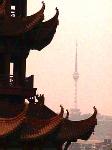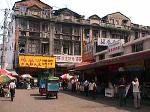- Getting around Lijiang. Dont stay in the Old Towns more than 2 days, there is nothing to do. KRISS Oct 9, 2013 05:46
- 2013 Beijing Temple Fair BENNYLAU Feb 26, 2013 03:29
- Malaysian traveling from KUL - LAX vis Shanghai PVG ZATI_DY Jan 3, 2013 20:15
Wuhan at Last
- Views: 5618
- |Vote: 0 0
- |Add to Favorites
- |Recommend to Friends
A Second Chance at Wuhan
Just a fortnight before when I'd had to hop through Wuhan, I'd been most disappointed that I'd lost the chance to have a look around. This time, as if by magic, or perhaps further bad itinerary planning, I found myself needing to take a friend through the town - well, actually a mega-city - on our way to Shanghai.
The morning after a late night dancing in a strange nightclub in Changsha, Steve, a friend of mine from New Zealand, and I set off for Wuhan. Wuhan really is enormous, given that it encompasses three separate loci on a bend in the Yangtze. Wuhan is a swelterhouse in the summer and home to another of China's most famous ancient pagodas, the Yellow Crane Tower.
The four hour train trip passed in a flash. The moody Hubei countryside which had so moved me not a fortnight before was brightly lit up under clear skies. Sky-blue trucks were connecting remote farms with modern China, with all its benefits and ills, and the dust on the slender roads was swept up at frequent intervals as they passed.
A Wuhan local with good English found us and sat down to chat. He was evidently a man who enjoyed wielding influence, as immediately upon hearing of our difficulties in finding passage to Shanghai, he was making calls on his cellphone to prepare a solution. He wouldn't hear of not inviting us to dinner, and upon arrival in Wuchang (at the same terminal near the Lulu hotel where Lao Hei & I had stayed - it was bizarre to be dropped at the precise same location twice in as many weeks, considering the distance covered) we were met by his attractive girlfriend, who'd not been informed we'd be arriving with her partner, but who seemed to take it in her stride - and escorted us to an expensive restaurant. Her English was equally fantastic, and she told us that she worked in television - smiling warmly at her boyfriend, she added, "he always does things like this". Within half an hour, a worried-looking young man arrived with two bed tickets for the next night's train to Shanghai. Aside from the cost of the tickets, we'd paid nothing at all for the service and hospitality, except perhaps for the very Chinese reward in 'face'.
Sophie
I have to confess that Sophie and I had first become acquainted as messenger buddies online. During the two years that I'd spent working as an Internet consultant for a New Zealand provider, I had become more than familiar with tales of Internet liaisons and its associated merits and pitfalls. However, over long evenings on customer support trapped in front of a PC and dreaming of visiting China, the thought of developing virtual rapports with people already there made it difficult to ignore company policy and not chat with girls whilst taking customers' calls.
At the time, Internet chat was much lass common than it is today, but by the time I eventually arrived in China, its popularity there was beginning to explode, with cheap Internet cafes opening in every small town across the country and with the growing success of China's own chat client - Tencent OICQ, commonly known as QQ. For whatever reason, QQ is host to a far more flirtatious community than is even the most notorious of American-based clients, and the phenomenon of travelling to meet Internet sweethearts, sometimes with disastrous results, is less and less unusual there. In some major Chinese airports, signs decorated with the QQ mascot, a cartoon penguin, state boldly: BEWARE OF ONLINE LIARS.
Sophie had given me instructions to relate to our taxi driver so that we could be driven to her parent's apartment where she was spending the afternoon alone. We arrived to catch her strolling out from the apartment drive, tall and slender with shimmering long hair, cool and warm in the hot sunshine - the stereotypical Hubei girl, healthy and bright. She casually took us up to her apartment where we chatted and waited for her family to arrive - we were to be invited out for dinner (again) to celebrate her mother's birthday with her, and also the news of her accepted application for residence in Canada. Within an hour we were both flattered and embarrassed to be received as friends on such an intimate family occasion, and I was personally delighted to see Sophie as a relaxed, charismatic member of this group of welcoming and warm-hearted people. Wuhan people have a reputation throughout China for their keen intelligence, and talking with Sophie's family, I realised there was some truth to the rumours.
Wuchang
Standing above Wuchang's great East Lake stands a huge statue of China's most famous poet, Tang Dynasty writer Li Bai, throwing an eagle into the air. It is said that on this site, after Li Bai had discovered a trapped eagle and set it free, he was so moved that his heart was released from the trappings of his studies and he went on to discover true freedom of the soul. As I stood beneath the enormous statue and looked out over the lake waters, I preferred to believe that the depiction of Li Bai represented the essence of the poetry inherent in the Chinese language, and that it is this power that has the ability to release the Chinese people to a destiny as the world's most advanced literary culture. It is to this that Chinese people refer to when they speak of 'the glory of our heritage'.
Sophie had taken Steve and I out early so that we had enough time to see as much of Wuhan as possible before having to leave in the late afternoon for Shanghai. Wuhan is truly an enormous city, and we were lucky to have the chance to see the lake district, where Sophie had spent much of her childhood, and I sensed from her a cautious delight as she revealed a side of herself that seemed deeply connected with the areas she was proudly showing to us; in a small way, she was letting down her guard, something rare for a girl from Wuhan.
We passed a couple of other minor sights - including an interesting governmental office once used by Dr Sun Yat Sen, who led the first revolution to liberate China from the Qing Dynasty overlords - before moving on to what is regarded as the symbol of Wuhan - the Yellow Crane Tower.
The Yellow Crane Tower
It's not the original, and although there has been a Yellow Crane Tower in Wuhan for about 1800 years, it has been razed and destroyed many times. This latest tower was reconstructed only 25 years ago - it is a faithful recreation, although it is wider than the last tower that burnt to the ground a century ago, and as a result is more stable. The tower is said to be built in memory of a magical priest who brought a picture of a crane he'd drawn a picture of that had come to life, and flew on its back to heaven. There's a large mural of the event in the entrance way to the tower.
Wandering through the tower and inspecting its grounds and artworks was nothing short of a magnificent experience. From the upper stories I was able to see far across Wuhan, a view obscured only by the thick smog that accompanies all provincial capitals. Wuhan from the air delivers one of those majestic views that are rare in China but an integral part of the country's magnitude. You get the same feeling standing under a huge overpass in Chongqing, or atop Shanghai's Jinmao Tower. It's the realisation that thousands of years after the conception of the Great Wall, Chinese engineering is still just as daring and visionary.
Hankou
Sophie took us across to the city opposite Wuchang, Hankou, for yellow soybean soup, a dish I'd not had since taking shelter after arriving in Harbin at 4am in -40°C cold. That had been hot and invigorating, this summer variant was cold and thin - a flavour that was initially unappealing in comparison with the New Zealand chocolates I'd been missing in China, but one which is so distinctively Chinese that I will always miss China when remembering the taste from overseas.
Hankou is the site of the former European colony in the region, and once again I was faced with the same kind of familiar, beautiful but sinister architecture of the European continent I'd seen in Dalian and Tianjin. Foreigners have always brought trouble to China, but as I observed these old colonial strongholds, pillars and marble pasted over in big Chinese shop signs and advertisements, ornately sculpted windows stacked with vegetables for sale, I couldn't help but smile at the ability of China to steadily and slowly, decade passing decade, reoccupy everything that has come to invade. Add to that China's capacity for recovering things once lost, like the Yellow Crane Tower, and it becomes easier to understand why the country has persisted in spite of it all.








 Copyright © 1998-2026 All rights reserved.
Copyright © 1998-2026 All rights reserved.